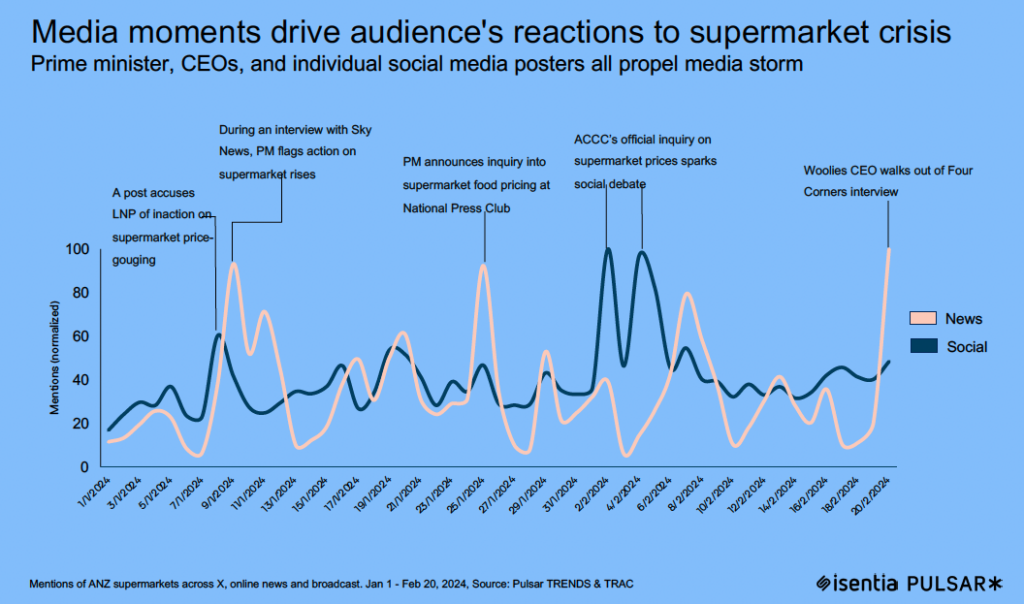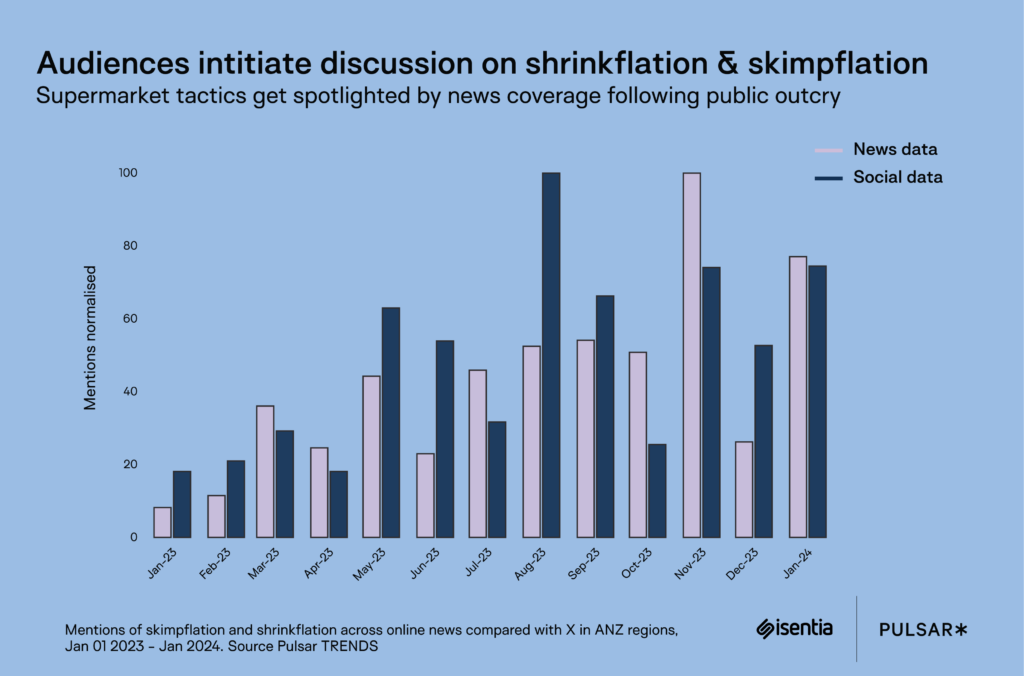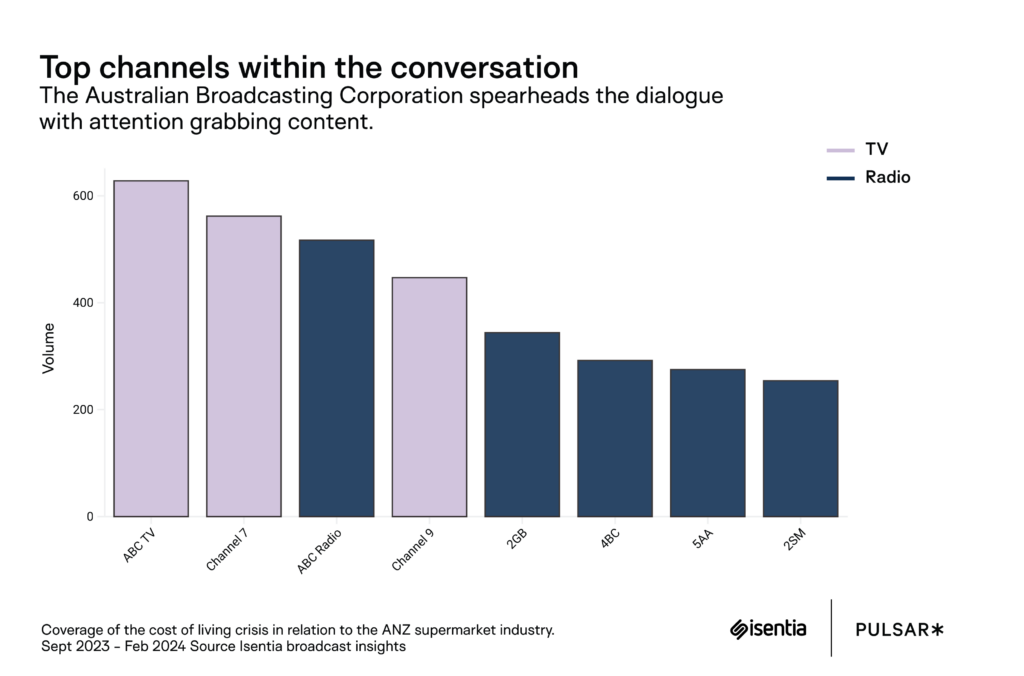Blog
TV News Network
Whether we like it or not, news networks play a huge role in how we form opinions. In fact, the news can be so powerful, it can even shape other news networks’ perceptions of truth.
The story around supermarket prices has been evolving for a number of months, finally reaching an inflection point as the Woolworth’s CEO appeared in a challenging interview with Four Corners and then announced his upcoming retirement only two days later.This chain of events underscores the critical importance of understanding the connections made by broadcast media, as they can significantly influence public perceptions and shape the narrative surrounding key industry players.
It was only the latest in a series of media items to seize Australia’s attention, and cast the nation’s supermarkets into something of a PR and Comms crisis.

And yet, viewing events through this framing also only gives a partial picture. As the discussion surrounding the impact of supermarkets on the rising cost of living intensifies, we’ve observed a notable surge in the usage of terms such as ‘shrinkflation’ and ‘skimpflation’. Reaching back even further, we can see how the topics attained a gradually greater place on Australian news and social channels. Shrinkflation and skimpflation are tactics employed by supermarkets during economic challenges. Shrinkflation involves reducing product sizes while maintaining prices, subtly passing on costs to consumers. Skimpflation maintains product sizes but compromises on quality to preserve profit margins. These strategies often frustrate supermarket shoppers, especially during economic strains like inflation.

Clearly, the topic has become ubiquitous. But if we want to understand how information and perceptions have been communicated to mainstream Australian audiences, then it becomes vitally important to pay particular attention to broadcast media.
Broadcast media (which includes television, radio and podcasts) plays a pivotal role in shaping public discourse and influencing perceptions, particularly on pressing issues such as the cost of living crisis.
Using Isentia to monitor these data sources, we gain valuable insights into their contribution to consumer attitudes. From identifying which organisations are most associated with the issue to pinpointing key public figures and preferred channels within radio and TV, broadcast media monitoring allows us to understand the complex dynamics that shape public opinion.
It’s the oldest of these media types which accounts for the most mentions of the supermarket crisis. Beyond reporting updates on the senate inquiry and government actions, radio excels in facilitating in-depth conversations between hosts and listeners, which surfaces more individual consumer stories than television or podcasts can match.

ABC’s predominant coverage of the topic corresponds with the network’s content strategy. Major programs such as the Supermarket Four Corners special and podcasts like The Briefing attract substantial listenership and garner attention from other channels. Channel 7, in addition to delivering key news updates, focuses on the shopper experience within supermarkets, shedding light on everyday challenges faced by audiences, such as navigating shrinkflation and skimpflation tactics.
Understanding the majority share of broadcast channels within this topic is important as it reflects who has the loudest voice, and is most persistently advancing a certain narrative or way of framing the situation.
Coles and Woolworths dominate the conversation, reflecting their prominent presence in the retail landscape. Their widespread accessibility and familiarity to consumers make them prime subjects for discussion in the context of rising costs and economic pressures.
Conversely, Aldi and IGA, while still significant players in the grocery market, may receive comparatively less focus in these discussions. Aldi’s reputation for offering lower-priced alternatives and IGA’s decentralised business model, with independently owned stores, may also contribute to their reduced presence in conversations about supermarket practices during times of economic strain.
Each channel and network approaches discussions about supermarket groups differently. While Coles and Woolworths understandably dominate each station’s broadcasts, the precise balance (and the time afforded to Adi and IGA) is revealing.
For instance, 4BC has encouraged audiences to diversify their shopping habits, with one 4BC broadcaster highlighting that “Aldi and IGA are actually doing more than the other two to really help enormously with the cost of living.”
In the discourse on supermarket practices during the cost of living crisis, a number key figures emerge across broadcast channels. Anthony Albanese, the Australian Prime Minister, is predictably prominent on just about every channel, particularly broadcaster 2SM.
All of them, that is, apart from the Australian Broadcasting Corporation (ABC), which spotlights Allan Fels, an economist and former ACCC chair who has analysed price gouging by major corporations. Other notable politicians mentioned include Treasurer Jim Chalmers, Craig Emerson, Steven Miles, and David Littleproud.
Media’s focus on these figures is crucial for shaping public discourse and policy responses amid economic pressures. While supermarkets are often discussed as a key antagonist in the cost of living crisis, they are increasingly being viewed in the context of potential solutions, particularly regarding government policy to regulate supermarket giants.
At the same time, focus does not only fall on the prominent individuals driving business decisions and policymaking. Country Hour (NSW), for instance, focused a story on cherry grower Michael Cuneo, who ceased selling to supermarkets after he made a financial loss on a shipment of fruit. And it was this story that achieved the greatest media reach of any radio content on the topic.
Clearly then, the topic has not played out in any one way across any one channel. The prominence of key figures and top broadcast channels in this conversation underscores the importance of understanding how media coverage impacts public discourse and regulatory decisions. Isentia’s broadcast capabilities offer unparalleled insight into the role of broadcast media in shaping the narrative surrounding supermarket practices. By harnessing Isentia’s monitoring and analysis tools, organisations can gain deep insights into how influential discourse and coverage can impact an industry.
Interested in learning more? Email us at info@isentia.com
Loren is an experienced marketing professional who translates data and insights using Isentia solutions into trends and research, bringing clients closer to the benefits of audience intelligence. Loren thrives on introducing the groundbreaking ways in which data and insights can help a brand or organisation, enabling them to exceed their strategic objectives and goals.
Whether we like it or not, news networks play a huge role in how we form opinions. In fact, the news can be so powerful, it can even shape other news networks’ perceptions of truth.
A practical guide to tailored stakeholder management, offering strategies and tools to identify, map, and nurture relationships.
Across the communications landscape, teams are being asked to do more with less, while staying aligned, responsive and compliant in the face of complex and often shifting stakeholder demands. In that environment, how we track, report and manage our relationships really matters. In too many organisations, relationship management is still built around tools designed for […]
Get in touch or request a demo.